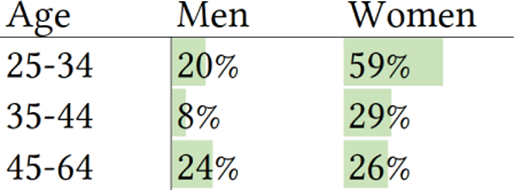
“I’ll put a link to that doc in the chat”
“Sorry, my internet is terrible, I’ll put my question in the chat”
“That GIF from Amy in the chat is hilarious”
Spotlight: AI-POWERED EXPERIENCE
If these phrases sound familiar to you, you’re not alone – people the world over use the chat function in Microsoft Teams and other video-calling services every day. But we could ask: why post messages in parallel to the main conversation? Does it improve or worsen the meeting experience? And crucially, what can we do to make it more effective?
Why do people chat – and is it a good thing for meetings?
To answer these questions, we conducted a study drawing on two sources of data: (1) the diaries of 849 Microsoft employees who journaled their experiences during the summer of 2020, when COVID-19 triggered widespread remote work and online meetings, and (2) a survey of 149 Microsoft employees that specifically asked how they used chat. The paper was accepted at the 2021 ACM CHI Virtual Conference on Human Factors in Computing Systems.
In the survey, the overwhelming majority (85.7%) of participants agreed that parallel chat is a net positive. Only 4.5% responded negatively, and 9.8% were neutral.
Chat messages themselves can contain a lot of different things: questions; links and documents; agreement and praise that add to what is being conveyed during the call; discussion of related and unrelated topics; and humour and casual conversation.
Many people did report being distracted by chat – it is difficult to focus on the audio/video (AV) of a meeting while also participating in the chat. People clash over different expectations around how to chat and how formal chat needs to be. For participants that fail to notice important chat entries, confusion can ensue. Moreover, chat poses challenges for people with reading difficulties or people who find it hard to understand sentiment in text. Images posted in chat may not come with alt text to help blind and low vision people understand them.
As one participant says, “[…] sometimes it’s very distracting as multiple threads are happening that get tangential from the main presenter/speaker. […] it’s really hard to keep track of multiple conversations AND pay attention to the speaker.”
And yet our research showed compelling benefits of chat within meetings, which argues for encouraging it, even as we continue to look for ways to minimize the negative consequences.
The many benefits of chat
Chat has become essential in virtual meetings – many online meetings would be much less efficient, and some would be impossible, without chat. Chat enables people to organize their collaboration and action around documents and follow-up meetings. It enables people to work around problems such as poor connectivity and technical issues, language barriers, and inscrutable jargon. It helps manage turn taking and questions/answers, especially in large meetings.
A survey participant explains, “there have been meetings where important links were able to be provided in the text chat, important and relevant topics were brought up and then incorporated into the meeting, etc – these are times when I feel like I really could not live without [it]”
Beyond these functional roles, chat also enables humor and casual conversation, which give meetings a much-needed sense of social support and connection.
As one participant puts it, “we use text chat to send ‘cheers’ and fun gifs to celebrate moments […] this tends to generate a lot of enthusiasm and makes these types of meetings more fun. like people’s personalities coming out.”
Perhaps most importantly, chat can be a means of inclusion. Chat enables people to participate without interrupting the speaker, preserving the flow of the meeting. It enables contributions from those who are shy or unable to speak. And by keeping a record of reactions to posts, it can help participants support good ideas that arise from the sidelines. One participant observed “people contributing through chat that might not have a voice otherwise – either limited by technology (no microphone), environment (loud, distracting) or personal preference (shy, new, still finding the way in the team’s culture.)”
Our poll data provided a specific example of chat’s power for inclusivity: women aged 25-34 were much more likely than any other group to report an increase in chat use after shifting to remote work. And women of every age reported more chat usage than men.

This is an important finding, because gender is associated with (opens in new tab) different meeting experiences and participation rates. Young women sometimes find it difficult to be heard during meetings, and our study suggests that chat gives them another way to participate. However, we should not equate participation in chat with speaking in the ‘main’ audio/video of the call, which is generally more significant.
More broadly, members of minority groups or people with disabilities may have positive or negative experiences with chat. This could include neurodivergent professionals and those who are blind or low vision. On the other hand, chat may enable greater participation for people who lack the ability to speak. Further study is needed to understand whether chat improves the inclusion of those who suffer from systemic disadvantage, or whether it is entrenching that disadvantage, perhaps even exacerbating it, by relegating their participation to a side channel.
How to make the most of chat in online meetings
Chat has both benefits and disadvantages. Used well, it can be a powerful and effective tool in online meetings. Used poorly, it can cause distraction and confusion. Based on our study, here are some guidelines for using chat effectively:
- Establish expectations about chat usage before the meeting starts. Clear guidelines will support chat that is inclusive, as well as productive.
- Consider accessibility challenges (e.g., some attendees may have difficulty reading text or understanding sentiment in text).
- Encourage chat that engages with the meeting topic or makes the meeting more inclusive. Discourage overly off-topic, exclusionary, inaccessible chat.
- Monitor chat for questions and comments and address them in the main conversation.
- Include a chat summary in meeting archives to preserve and share ideas and feedback.
We’ve also written a meeting chat guide with more explanation of these guidelines.
Chat to the future
Improving chat can lead to more effective conversations as well as enhanced meeting tools. Based on our study, we identified several opportunities for enhancing chat through design. For example, we could use machine learning, or a tagging feature, to identify and differentiate between types of chat messages, so participants could visually recognize questions, clarifications, comments, kudos, on and off-topic talk. We could better integrate chat with the main audio-video conversation by showing indicators of whether chat is quiet or busy, highlighting messages containing terms that match what is being discussed, and integrating images and websites in the chat into the main video stream. For a longer list of opportunities, see section 4.2 of our paper.
The age of online meetings has just begun. We’re still learning how to build tools for effective online collaboration. Even in things as unassuming and prosaic as chat, there are challenges but also tremendous opportunities.
In the spirit of using poetry to help communicate science (opens in new tab), we leave readers with a poem written by the first author (Advait Sarkar) that takes inspiration from our study, which was conducted during a pandemic that kept us all apart far longer than expected:
Summer came, but winter’s game
Would see no end
The micro-reign, devil stain
Cleft foe from foe, and friend from friend
Learnt we swift, our this day’s gift
To meet apart
Let sound, sight, and what we write
Join head to head, and heart to heart
Want to learn more? Read our paper.
Acknowledgments
This research was authored by Advait Sarkar, Sean Rintel, Damian Borowiec, Rachel Bergmann, Sharon Gillett, Danielle Bragg, Nancy Baym, and Abigail Sellen and part of a larger project about meetings during the COVID-19 pandemic.





